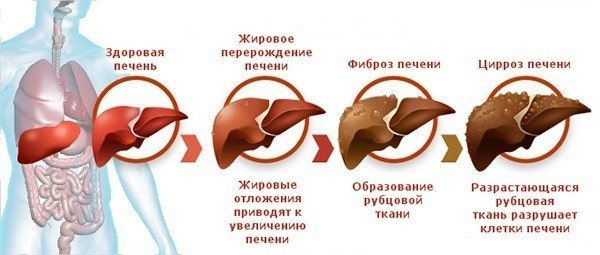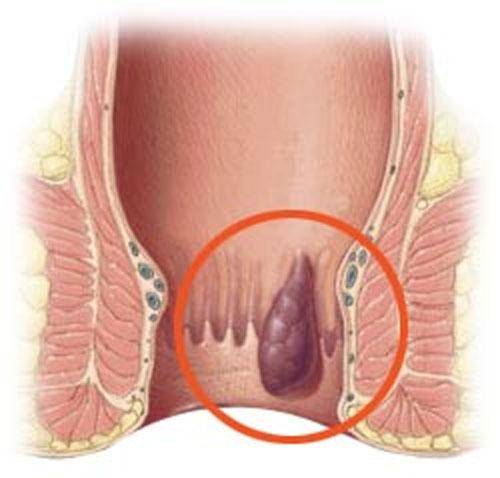Liver cirrhosis is a dangerous disease that, even with proper treatment, only progresses over time. With this disease, irreversible pathological processes occur in the body, leading to liver destruction and dysfunction. The tissues of the organ begin to change their structure and are gradually replaced by fibrous compounds.
Cirrhosis of the liver
Even now, when medicine and pharmacology are well developed, it is almost impossible to completely cure this disease, and very often doctors do not give a favorable prognosis. It is impossible to say specifically how many people live with cirrhosis of the liver.
Liver cirrhosis is a disease in which hepatocytes are replaced by fibrous tissue. People dependent on alcoholic beverages are more susceptible to developing this disease. Very often the cause of liver cirrhosis is chronic hepatitis. How long the patient will live depends on what stage the disease is at, what caused its occurrence and the individual characteristics of the body.
Factors that influence life expectancy in liver cirrhosis
So, how many people live with liver cirrhosis and is there a chance of being completely cured of the pathology?
As practice shows, it is possible to slow down the development of the disease and improve a person’s condition, but only if the disease was diagnosed in the early stages. If pathological processes have been destroying the organ for more than a year, and serious changes have occurred in the body, the prognosis will be disappointing. According to statistics, the most likely cause of liver cirrhosis is alcohol abuse. The only chance of survival for a person with such a pathology is an organ transplant. But according to Russian law, a person who suffers from alcohol addiction cannot be included in this list.
The most likely cause of liver cirrhosis is alcohol abuse
Alcoholic cirrhosis of the liver in this case will sooner or later lead to death. Medical experts say that very often the rate of progression of the disease and, accordingly, a person’s life expectancy depends on the following factors:
- to what extent the patient adheres to a correct lifestyle;
- patient's age. Numerous studies have shown that young people are several times more likely to avoid death;
- general condition of the body;
- which acted as the primary source of cirrhosis. For example, if the disease is caused by hepatitis, the probability of successful treatment will be more than 60%;
- the presence of other chronic diseases.
Forecast at different stages
Average survival prognoses depending on the stage of development of cirrhosis are as follows:
- compensated stage. Most of the parenchyma of the organ remains healthy and takes over the functions of dead cells. Symptoms of the disease are absent or mild, without affecting the quality of life. The patient occasionally feels discomfort and heaviness in the right side after overeating or drinking alcohol; sometimes there is increased fatigue and a depressed mood. At this stage, changes in laboratory blood parameters change slightly; ultrasound reveals a form of cirrhosis: biliary, small nodular or large nodular. Undestroyed hepatocytes work with increased load. With certain restrictions in diet and taking medications, almost half of patients are able to live up to 15–20 years. The longest duration is in young people, people without cardiovascular diseases, who do not drink alcohol;
- subcompensated stage. Most of the parenchymal tissue is affected. The patient experiences moderate symptoms of cirrhosis. Periodically or constantly there is nausea, distension in the right side of the abdomen, gums bleed, hematomas and spider veins appear on the skin. Hair fall out. Performance decreases, appetite disappears, and headaches often occur. With biliary cirrhosis, jaundice appears. The body temperature is subfebrile, periodically rising to 38–39°C. How long you can live with liver cirrhosis at this stage depends on the form of the disease and the patient’s compliance with the prescribed restrictions. The average survival rate is 5–7 years. But this figure is average. Any violation of the regimen is not beneficial to the patient, and complications such as portal hypertension or accumulation of fluid in the peritoneal cavity - ascites - significantly affect the quality of life and reduce its remainder. The patient is forced to spend a lot of time in bed, often going to the hospital for therapy;
- decompensated stage. Stage 3 liver cirrhosis is characterized by damage to the entire tissue volume of the organ. For most patients, this period is near death. Processes such as massive ascites, severe internal bleeding, and encephalopathy develop. The liver, as they say, “fails.” The appearance of such patients directly indicates their condition: the skin becomes yellow-gray, flabby, with a dark network of blood vessels, the limbs are emaciated, the stomach is large, and the hair is sparse. Therapeutic treatment of this degree no longer prolongs life, but alleviates painful symptoms. The survival prognosis for 80% of patients is no more than 1 year. In some cases up to 3 years;
- terminal stage. It can be called agony, since the liver can no longer function independently. Patients in this condition are on life support systems in a hospital setting. The prognosis is extremely unfavorable - death occurs within a few weeks.
The influence of various diseases on cirrhosis
If a woman or man who has been diagnosed with liver cirrhosis has any chronic disease, the prognosis will be more negative. Chronic diseases aggravate the process of liver destruction and reduce human life expectancy. In addition, some diseases are a contraindication for the necessary therapy and taking specific medications. If a person suffers from cirrhosis of the liver accompanied by ascites, he will not be able to take non-steroidal anti-inflammatory drugs and aminoglycosides, since these medications in rare cases can provoke bleeding in the biliary tract. In addition, the possibility of the following complications cannot be excluded:

Coagulopathy
- dilation of the walls of the veins in the stomach;
- hepatic encephaly;
- coagulopathy;
- peritonitis.
But if you do not take such drugs (especially at stages 2 and 3 of the disease), the likelihood of improvement in the condition will be practically reduced to zero.
Symptoms of the disease
If cirrhosis is detected early, a complete cure is possible, so it is important to pay attention to the signs of each stage of the disease. The first two are characterized by:
- lethargy, fatigue, decreased performance;
- sleep disorder: night wakefulness is replaced by daytime sleepiness;
- decrease in pressure;
- anemia;
- bleeding from the nose, gums;
- from the digestive system: nausea, vomiting, bloating, diarrhea;
- stool lightening;
- darkening of urine;
- weight loss;
- yellowness of the skin, sclera, eyes;
- skin itching;
- redness of the palms and feet;
- the appearance of spider veins on the face.
For stages 3 and 4, the characteristic manifestations of cirrhosis are:
- enlargement of the upper phalanges of the fingers;
- stomach and intestinal bleeding;
- signs of ascites: the shape of the abdomen changes, it increases in the lower part due to the accumulation of exudate;
- signs of portal hypertension: a vascular pattern appears in the navel area;
- anemia, pallor;
- significant weight loss;
- Digestive disorders are permanent.
This is interesting: Treatment of liver cirrhosis with drugs: the most effective remedies for cirrhosis
Survival rate for stage 1 cirrhosis
If a person suffers from stage 1 liver cirrhosis, the symptoms of the disease will be mild; at this stage, ascites (abdominal dropsy) almost never develops. If the patient seeks professional help in time, pathogenic inflammatory processes can not only be slowed down, but also stopped. To select the optimal drug therapy, a person will need to undergo multiple examinations and undergo various tests. If the results show an increase in ALT and AST, this is a sure sign of destruction of the structure of the liver cells. The concentration of bilirubin and albumin may be within normal limits. Only if hepatitis progresses quickly will the organ tissue continue to deteriorate, and the patient’s life expectancy will be limited to 10-15 years. The main symptoms of stage I liver cirrhosis are:
- constant headaches;
- general weakness and increased fatigue;
- partial loss of performance;
- lethargy and apathy;
- Men may develop gynecomastia.
Despite the fact that such violations are minor and have virtually no effect on treatment, they negatively affect the patient’s mental state and general mood. The prognosis for stage 1 liver cirrhosis in children is favorable; if a small patient is given appropriate treatment, he will be able to live a fairly long life. Modern medications activate the reserve reserves of the liver, due to which it begins to quickly recover and fights the inflammatory process.

To prolong life with hepatitis and cirrhosis of the liver, a person also needs to lead a correct lifestyle, as well as review his diet and drink as much mineral water as possible. All this together helps remove toxins from the body.
Treatment
The body at stage 4 of cirrhosis is so weakened that conservative treatment can only stop the process of destruction of liver tissue. The patient's symptoms are eliminated, his condition is alleviated, and his quality of life is improved in the last months or days. The patient’s relatives should prepare for possible deterioration of the patient’s condition, know how to treat him and how long they live with such complications in clinics. Even with emergency medical care, a successful outcome in case of coma and recurrent bleeding is unlikely.
Treatment of grade 4 cirrhosis consists of improving blood composition: the patient is given transfusions of plasma and albumin solution. Intoxication of the body is relieved by the introduction of vitamin preparations. Hepatoprotectors support the activity of the remaining functional parenchyma cells. Taking hormonal medications stops the growth of connective tissue.
For ascites, accumulated fluid is pumped out from the abdominal cavity; for varicose veins, the vascular walls are strengthened. Transplantation of a part of a healthy organ at stage 4 of cirrhosis is not performed due to the patient’s poor health. It is possible to remove cancerous foci of the parenchyma, part of the enlarged spleen.
This is interesting: Small nodular (micronodular) cirrhosis of the liver: symptoms, gross specimen, treatment and life expectancy
Liver cirrhosis stage 2
Stage 2 of the disease (subcompensated) is manifested by very pronounced symptoms: the patient’s temperature rises, pain in the right hypochondrium often occurs, and pain in the joints also appears. The patient's skin becomes yellow, and xanthelasmas develop on the eyelids.
How long a person will live with stage 2 liver cirrhosis also depends on how old the patient is and on the general condition of his body. With stage 2 liver cirrhosis, the patient can live about 10 years. But if the disease is accompanied by liver failure or dropsy, life expectancy will be reduced to 5-6 years. The cause of death is neglect of medical recommendations and continued consumption of alcohol. It is possible to say more specifically how long people with cirrhosis live only after a complete diagnosis and identification of the severity of liver failure, as well as the content of bilirubin and albumin. If the dropsy is severe, the patient's life expectancy will most likely be reduced by several years.
How long can you live with liver cirrhosis of various etiologies?
The disease can be caused by various reasons, this factor affects the success of treatment and how long patients live. For example, with biliary and alcoholic cirrhosis at the first stage, a favorable outcome is allowed. To do this, a person must completely eliminate alcohol. If stage 2 or 3, then life expectancy will be 6 years or more.
For the biliary type of the disease, the period is 5-6 years from the first appearance of signs of the disease. The most severe type of illness is considered to be viral. In advanced situations, combinations of alcoholic or toxic pathology with a viral one are diagnosed. This indicates imminent death even with effective therapy. The only salvation may be an organ transplant.

Liver cirrhosis stage 3: life expectancy
Decompensated cirrhosis – stage 3 is accompanied by weakness, diarrhea, vomiting, sudden weight loss, and bleeding. The stage is characterized by serious complications such as hepatic coma, sepsis, and liver cancer. The patient's risk of death is very high.
The life prognosis at this stage depends on the course of the disease. Patients who have been diagnosed with this pathology live with the diagnosis for about 4-5 years. But if certain symptoms are present, life expectancy may be shortened; the course of the disease is especially negatively affected by:

Haemorrhoids
- the appearance and development of hemorrhoids. This disorder usually occurs due to increased abdominal pressure;
- change in the position of internal organs;
- effusion into the pleural cavity;
- formation of a hernia in the diaphragm.
If a patient with alcoholic cirrhosis receives adequate treatment, he will live 1-2 years longer. But since in alcoholics the main liver cells are replaced by fibrous tissue, it will not be possible to increase life expectancy for a long period, regardless of the prescribed treatment. The only thing that can significantly help the patient in this situation is an organ transplant. If the patient receives a new liver, he will be able to live 7-10 years longer, but only if there are no viral infections, otherwise the new liver will also begin to deteriorate. Most often, with third-degree cirrhosis, the following complications appear:
- most of the veins of the biliary tract dilate, the same thing happens in the rectum;
- the patient periodically experiences gastric bleeding;
- severe renal failure develops;
- a huge amount of toxins accumulate in the blood, which leads to general intoxication;
- Some patients develop malignant neoplasms.
Each of these symptoms in liver cirrhosis significantly complicates a person’s life; taking painkillers does not bring relief.
Impact of concomitant diseases and complications
The prognosis of life with cirrhosis is determined by both causes and complications. More often, pathologies are associated with portal hypertension - an increase in blood pressure in the portal vein. Typically, this picture is observed at stages 2–3.
Ascites
One of the main causes of death in liver cirrhosis. Ascites is an accumulation of fluid in the abdominal cavity.
In the presence of such a symptom, the prognosis is no higher than 3 years in 25% of patients. The addition of liver failure shortens the period to 1 year. If the disease is diagnosed at the last stage, the person has several months left. Usually this picture occurs against the background of a comatose state.
Hepatic coma
Encephalopathy means the progressive death of brain cells due to poisoning by substances that the diseased liver could not neutralize. Usually accompanies cirrhosis at an advanced stage. Healthy brain cells are not able to take over the function of dead ones. As a result of insufficient functioning of the central nervous system, a person falls into a coma, which leaves almost no chance of recovery.
As a rule, death comes quickly, within a couple of months. Life support is provided in an inpatient or rehabilitation department. Death occurs in 80–100% of cases. To save a person, an urgent transplant is necessary, but it is difficult to obtain a liver that is completely compatible with the patient’s tissues in such a short time. The ideal option is to collect part of the organ from the closest blood relative.
Portal vein thrombosis and bleeding
This complication accompanies 40% of pathologies at the last stage. It is difficult to identify it, since there are no characteristic signs. Only with advanced disease does bleeding develop.
The cause of the complication is an increase in pressure in the lumen of the portal vein and problems with blood clotting. Often the disease is accompanied by dilation of the veins and capillaries in the digestive tract, which also leads to bleeding.

The mortality rate from liver cirrhosis with esophageal bleeding is about 40%. It is the leading cause of death in cirrhosis.
Irreversible changes provoke thrombosis - the formation of clots. This condition is treatable, so acute thrombosis is rarely diagnosed in people undergoing treatment. To identify pathology, it is enough to undergo a Doppler ultrasound.
Thrombosis is treated with intravenous administration of drugs that destroy clots and prevent the formation of new ones. In the presence of bleeding, dilated vessels are ligated using endoscopic methods.
Liver cancer
The prognosis for liver cirrhosis, manifested against the background of oncology, is extremely unfavorable. Surgery is used to reduce risks. But the 5-year survival rate for such a diagnosis is only 20%.
Relapses and metastasis of the malignant tumor to other organs lead to worsening of the condition. In addition, with advanced stage cancer, only palliative (supportive) treatment is possible; surgery is useless. Therefore, doctors are faced with the task of maximizing the patient’s life by reducing the manifestations of the clinical picture. Sometimes surgery is needed to prevent complications:
- intestinal obstruction;
- bleeding;
- ascites;
- peritonitis;
- violation of the integrity of the bile ducts.
At stage 4 oncology, survival rate is no more than 4%. In addition to the liver, the lungs, brain tissue, and skeleton are also affected. Survival rates are up to 5%, but largely depend on the quality of care.
Peritonitis
Death from cirrhosis often occurs due to inflammation of the peritoneum. The development of an infectious process and peritonitis significantly shortens life. Although tissue destruction occurs slowly, complications usually last about 3 years.
Cirrhosis stage 4: how long can you live?
The stage of decompensation is manifested by the development of encephalopathy against the background of long-standing portal hypertension. Encephalopathy or hepatic coma is a disorder of the nervous system, namely its functions, with severe liver damage. It manifests itself as severe headaches and dizziness, memory deteriorates sharply, hallucinations and delusions appear, the person begins to behave inappropriately, as well as neurological signs of deterioration of the nervous system.
The prognosis for stage 4 cirrhosis is extremely unfavorable. At this stage, the patient experiences multiple complications, which practically reduces the likelihood of survival to nothing. This disease is so dangerous that the patient can live for a maximum of 3 years. Almost always with this disease, dropsy appears, leading to the accumulation of lymphatic fluid. If excess fluid begins to accumulate in the abdominal cavity, a person experiences severe swelling of the limbs. Ascites in cirrhosis and hepatitis leads to the following pathologies:
- increase in abdominal size;
- sagging skin with fatty layers;
- formation of hernias;
- Upon physical examination and touch, a specific sound may be heard.
The developed form of ascites almost always leads to inflammation of the parietal pleura, which in 80% of cases causes death. The sure signs of stage 4 alcoholic cirrhosis are:

Increased body temperature
- the appearance of cutting pain in the abdominal cavity;
- constant increase in body temperature;
- blood leukemia;
- when listening to the intestines, there will be a complete absence of noise in the organ;
- development of encephalopathy.
According to statistics, at this stage, many patients fall into a coma before death. Coma is poisoning of the brain by cerebrotoxins. Before the onset of coma, very strong drowsiness is noted, the patient’s consciousness is confused, and a very strong smell of ammonia appears from the oral cavity. The liver becomes smaller in size, and the spleen, on the contrary, increases. Anemia, leukopenia develops, the level of prothrombin decreases, which causes bleeding. Coma may also be accompanied by brain damage. Usually in this state, the patient will no longer be able to come out of the coma. Then the patient dies.
Life expectancy with liver cirrhosis is also affected by the presence of diseases of other organs. With adequate medical therapy, the patient's life can be extended by 20 years. According to statistics, on average, people with cirrhosis of the liver live 7-10 years. If the disease is detected earlier, the prognosis is favorable, since restorative treatment therapy can stop the progression of the disease.
With subcompensated cirrhosis, a reduction in hepatocytes occurs. With this type of cirrhosis, they will not be able to ensure full functioning of the liver. Life expectancy for stage 2 liver cirrhosis is, on average, about 5 years. At stage 3, survival depends on the severity of the disease. Approximately half of patients with this diagnosis live more than 3 years. If a person experiences complications, the period will be shortened, and the prognosis will be the most unfavorable. With grade 4 cirrhosis, very serious complications arise, so maximum survival is no more than 3 years. So, with encephalopathy, the patient can live no more than one year, especially if a coma occurs.
A disease that is viral in nature is also very actively developing. Alcoholic cirrhosis in combination with a virus develops very quickly. If alcoholic cirrhosis is found in women, then the prognosis is less favorable than with the same condition in men. This is explained by the fact that the cells of a woman’s body are most sensitive to the toxic effects of alcohol.
Liver cirrhosis is a disease that in most cases is severe. Men and women with this diagnosis suffer from severe pain, which even intravenous painkillers cannot help relieve. The only chance to prolong life and survival is a timely visit to a medical specialist when warning symptoms appear.
How long do people live with complicated liver cirrhosis?
Another characteristic of this disease is severe complications: ascites, liver failure, portal hypertension, encephalopathy. The mortal danger is the opening of internal bleeding, usually in one of the areas of the gastrointestinal tract or from the veins of the esophagus. Life expectancy is 3 years in half the cases.
Ascites is considered another severe form of complication. Only 25% of people live up to 3 years, most die before this period. In the case of hepatic encephalopathy, the doctor predicts an unfavorable outcome. On average, patients do not live more than a year. If you ignore doctor's recommendations, life expectancy is sharply reduced.
- Folk remedies for hemorrhoids are the most effective. How to treat hemorrhoids with folk remedies in women and men
- Mascarpone - what is it: recipes with cheese
- Fruit salad: recipes with photos
Favorable conditions and measures to prolong life
Only the last stage of cirrhosis is incurable, when even with a liver transplant, doctors do not give encouraging prognoses for liver cirrhosis, since irreversible changes occur in the body.
If a person turns to the clinic for help in time, then in most cases, with powerful treatment of the disease, good results can be achieved and the life span can be significantly extended. With a compensated or even subcompensated stage of the disease, a person can live twenty years, or even longer.
To do this, you need to carry out a number of activities:
- if viral hepatitis is detected, undergo the most effective treatment with the latest drugs (Sofosbuvir, Daclatasvir and Ledipasvir give almost one hundred percent positive results in the stage of compensated cirrhosis);
- to facilitate the functioning of the liver, follow a strict diet balanced in proteins, fats and carbohydrates;
- completely eliminate any alcoholic beverages;
- treat with drugs to restore liver function;
- go to water resorts - Essentuki, Kislovodsk, Truskavets;
- protect yourself from any infectious diseases, colds, ARVI;
- treat all diseases in a timely manner, cure caries and other sluggish pathologies;
- do not engage in heavy physical labor;
- switch to gentle work with reduced working hours;
- sleep well, walk in the fresh air;
- enlist the support of relatives.
All patients are interested in how long one can live with liver cirrhosis, how long a person can live with properly organized treatment. It is important to understand that cirrhosis of the liver is the most serious damage to this organ and most often it occurs due to the fault of the patient himself - an alcoholic, a drug addict, a person leading an antisocial, unhealthy lifestyle. Therefore, you should not hope for a quick and miraculous treatment. Treatment of the disease is painstaking work, therefore, how long people live with cirrhosis of the liver also depends on the patient’s desire to be cured. Not all people suffering from this disease understand the importance of proper treatment and abstinence from alcohol - it is much more difficult for them to overcome the disease. If the pathology occurs in a person who takes responsibility for their health, then in most cases such people live a long time, although their quality of life suffers significantly.
How long do people live with this diagnosis of the fourth degree?
This degree is the most difficult and dangerous ; people with this pathology are much less likely to live long and the maximum life of patients will be up to three years.

If fluid accumulates in the abdominal cavity, then the lower and upper extremities immediately begin to swell.
The manifestation of ascites may be due to the following reasons:
- excessive permeability of liver vessels;
- additional pressure from the hepatic vessels;
- if sodium retention occurs in the blood;
- with the accumulation of a large amount of lymph in the liver.
Ascites may manifest itself as additional symptoms , which include:
- the occurrence of hernias in the navel, groin or thigh;
- excessive abdominal enlargement;
- the sound of a drum when percussing the abdomen.
Dropsy of the abdomen must be identified and eliminated in time . If treatment is delayed, the patient may experience death , which can also be caused by the presence of peritonitis.
If peritonitis occurs, immediate medical attention should be sought. The fact is that the accumulation of fluid in the abdominal area irritates the parietal peritoneum .
Influences of gender and age
If we are talking about an elderly person suffering from cirrhosis, then the prognosis is much worse than for young people. This is due to the presence of chronic diseases and advanced stages of the disease.
Attention. Women have a higher mortality rate from liver cirrhosis than men because women's cells are more sensitive to ethanol.
Statistics
Predictions about how long a person with cirrhosis will live can only be made on the basis of appropriate tests and the conclusions of medical professionals. In many ways, life expectancy depends on the degree of compensation of this organ.
If we take as an example the ideal model of the development of events - timely diagnosis revealed the disease at the initial stage, therapy was correctly prescribed and carried out, the patient maintains his condition with medication. Then we can hope that the process and symptoms of liver decomposition will be stopped, and the organ will be able to function normally. According to statistics, life expectancy in such cases is up to 10 years.
In more severe forms of the disease (subcompensated form), when the destructive process has affected a significant number of cells and replaced them with fibrous tissue, the patient’s life expectancy is reduced to 5 years.
The decompensation stage gives, according to statistics, the lowest survival rate, and patients manage to live for about three years.
In the case of the development of hepatic coma and hepatic encephalopathy, the prognosis is the most disappointing - very rarely stage 4 is without death











